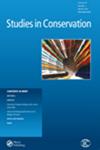The Use of Smalt in the Japanese Folk Paintings, Doro-e and Megane-e (Vue d'Optique)
IF 0.8
4区 化学
0 ARCHAEOLOGY
引用次数: 0
Abstract
ABSTRACTDoro-e refers to a genre of Japanese folk paintings: it is a group of works, likely to be produced from the mid-eighteenth to the nineteenth century, that emerged during a time when some of the techniques of European paintings, such as vanishing point, perspective, and mirror image were being incorporated into traditional Japanese paintings. Indeed, doro-e paintings played an important role in familiarising the Japanese public with these new techniques. However, the process of painting doro-e including materials and painting techniques used has not been interpreted, and the definition of doro-e remains elusive. This article begins by exploring Kamigata doro-e, particularly megane-e (vue d'optique), which was painted in the initial period of doro-e works. Materials analysis indicates the use of smalt, which is not often found in traditional Japanese paintings. Indigo was also used to depict landscapes, indicating that traditional blue dye was still the preferred colour for European-influenced paintings during the Edo period (1603–1868). This study also discusses the application of gold-coloured outlines identified as brass. A diversity of colourants and techniques was used in doro-e, a fact that is not reflected in the current definition regarding doro-e, and is discussed in this article.KEYWORDS: Doro-eJapanese folk paintingMegane-e (vue d'optique)painting for optical viewing deviceKamigatabrass AcknowledgmentsThe authors thank the late Hanae Shiba for providing doro-e collections to conduct this research.Disclosure statementNo potential conflict of interest was reported by the author(s).Additional informationFundingThis work was supported by JSPS KAKENHI: [Grant Number JP19K21647].日本民俗画中“小”与“小”的运用
【摘要】doro -e是日本民间绘画的一个流派:它是一组作品,可能产生于18世纪中期到19世纪,当时欧洲绘画的一些技术,如消失点、透视和镜像被纳入日本传统绘画。事实上,在让日本公众熟悉这些新技术方面,多萝西画发挥了重要作用。然而,doro-e的绘画过程,包括所使用的材料和绘画技术都没有得到解释,doro-e的定义仍然是难以捉摸的。本文将从探索神潟的彩绘开始,特别是在彩绘作品的初始阶段绘制的megane-e (vue d'optique)。材料分析表明,使用了日本传统绘画中不常见的小材料。靛蓝也被用来描绘风景,这表明在江户时代(1603-1868),传统的蓝色染料仍然是受欧洲影响的绘画的首选颜色。本研究还讨论了确定为黄铜的金色轮廓的应用。在doro-e中使用了多种着色剂和技术,这一事实没有反映在目前关于doro-e的定义中,本文将对此进行讨论。关键词:doro-e日本民间绘画;用于光学观看装置的megane -e (vue d'optique)绘画;amigatabrass致谢作者感谢已故的Shiba花荣(Hanae Shiba)提供doro-e收藏品以进行本研究。披露声明作者未报告潜在的利益冲突。本研究得到了JSPS KAKENHI的支持:[批准号JP19K21647]。
本文章由计算机程序翻译,如有差异,请以英文原文为准。
求助全文
约1分钟内获得全文
求助全文
来源期刊

Studies in Conservation
化学-分析化学
CiteScore
1.80
自引率
12.50%
发文量
73
审稿时长
>12 weeks
期刊介绍:
Studies in Conservation is the premier international peer-reviewed journal for the conservation of historic and artistic works. The intended readership includes the conservation professional in the broadest sense of the term: practising conservators of all types of object, conservation, heritage and museum scientists, collection or conservation managers, teachers and students of conservation, and academic researchers in the subject areas of arts, archaeology, the built heritage, materials history, art technological research and material culture.
Studies in Conservation publishes original work on a range of subjects including, but not limited to, examination methods for works of art, new research in the analysis of artistic materials, mechanisms of deterioration, advances in conservation practice, novel methods of treatment, conservation issues in display and storage, preventive conservation, issues of collection care, conservation history and ethics, and the history of materials and technological processes. Scientific content is not necessary, and the editors encourage the submission of practical articles, review papers, position papers on best practice and the philosophy and ethics of collecting and preservation, to help maintain the traditional balance of the journal. Whatever the subject matter, accounts of routine procedures are not accepted, except where these lead to results that are sufficiently novel and/or significant to be of general interest.
 求助内容:
求助内容: 应助结果提醒方式:
应助结果提醒方式:


